Sea trout fishery statistics - 2012 season
Sea trout catch statistics for Scotland for the 2012 season.
Catch And Effort Reported By Scottish Sea Trout Fisheries In 2012
The rod and line fishery
In total, 6,471 sea trout were reported caught and retained in the rod and line fishery. A further 15,580 sea trout were reported caught and released. We have no comprehensive time series of fishing effort information associated with the rod and line fishery.
Total rod catches (retained and released) of sea trout for Scotland as a whole have declined over much of the period since 1952, when our records began. Although catches have shown a slight increase since 2008, total reported rod catch in 2012 was the fifth lowest in the 61-year time series ( Figure 1).
Finnock are sea trout which have spent only a few months at sea before making their first return to fresh water. They may also be known as whitling or herling. Finnock catches have been reported since 2004 and are not included in any of the longer term data sets summarised here. The total rod catch of finnock in 2012 was 7,123 which was an increase of 0.4% compared to the previous 5-year average ( Figure 1).
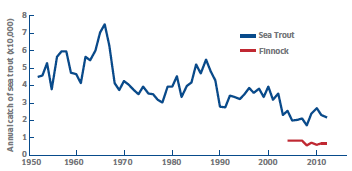
Catch and release
The proportion of the rod catch accounted for by catch and release has generally increased since 1994, when catch and release information was first recorded ( Figure 2) and accounted for 71% of the total rod catch in 2012. Overall 92% of finnock taken by the rod fishery were subsequently released in 2012.
Figure 2 Catch and Release, Rod and Line Fishery
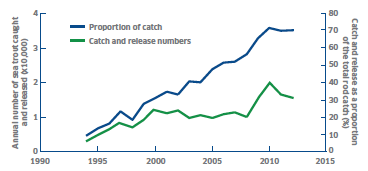
Comparison of catches among geographic regions
Analysing the catch data at finer geographical scales reveals differences among regions in the relative strength of 2012 catches compared to available historical data. Annual reported rod catch (retained and released) for each region was ranked over the time series from 1952 to the present (1=lowest, 61=highest). Thus, a rank value of 1 would indicate that the catch for that year was the lowest recorded in the time series for that region, while a value of 61 would indicate a region's highest recorded catch.
The values for the 2012 catch in each region are shown in Figure 3. Colours also reflect these ranking values for the regions (shading from lightest to darkest indicate ranking values from lowest to highest). Orkney and Shetland have been omitted from this regional analysis as they are not considered to have been fully covered by the survey over much of the time series.
Figure 3 Relative Strength of 2012 Rod Catch Among Regions
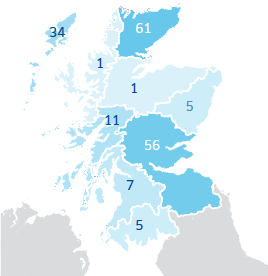
There are clear differences among geographic regions in the relative strength of the 2012 rod catch. All mainland regions in the west of Scotland reported catches which were within the lowest eleven recorded for their region over the period 1952 to 2012. The reported catch in Moray Firth and North East regions were, similarly, the lowest and fifth lowest respectively over the same period. Catches in the East and North regions in 2012 were, on the other hand, both among the top ten catches recorded within their respective regions, while the catch recorded in the Outer Hebrides was close to the mid-point in the time series.
The net fisheries
Overall, 2,433 sea trout were reported caught and retained in the fixed engine fishery. The national index of fishing effort was 236.5 trap months. A total of 2,682 sea trout were reported caught and retained in the net & coble fishery, and the reported effort was 78.5 crew months.
Reported catch and effort in both net fisheries have declined over much of the period covered by our records and remain at historically low levels ( Figures 4 & 5). In 2012, fishing effort in the fixed engine and net & coble fisheries was the fifth and sixth lowest, respectively, since records began in 1952. Reported catch in each fishery was 4% and 1% of the maximum reported in the respective time series.
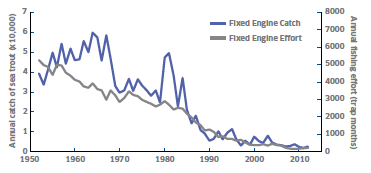
Figure 5 Net and Coble Fishery
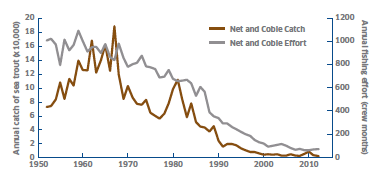
Contact
There is a problem
Thanks for your feedback